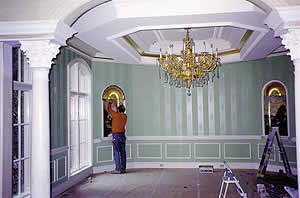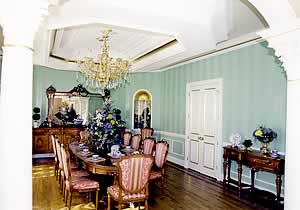
Faux Painting, Decorative Gilding
Whether decorative, protective or for another purpose, gilding is still being created and in much the same way as centuries ago. Gilding - whether with gold, silver, platinum, palladium or an alloy - is usually laid by hand a leaf at a time.
By Dave Cagle
of ancient Egypt, Tut-Ankh- Amun, died 3,300 years ago and a gilded mask was created to cover his mummified face, artisans were overlaying metal on many surfaces. The visors on U.S. astronauts’ helmets were covered with gold to protect their eyes from the sun’s fiery rays.
Numerous public buildings are graced by gilded domes. Even pastry chefs like the stuff, including edible gold and silver in decorative chocolates and wedding cakes.
Whether decorative, protective or for another purpose, gilding is still being created and in much the same way as centuries ago. Seen most often on picture frames and architectural structures, gilding — whether with gold, silver, platinum, palladium or an alloy — is usually laid by hand a leaf at a time.
 Like all good painting, gilding requires thorough preparation of the surface. It needs to be hard, smooth and free of contaminants. After that, the size or adhesive is brushed, sprayed or rolled. Once the size has dried to the appropriate tackiness, the leaves are applied, one by one or from a roll, and slightly overlapped. They are then pressed or tamped into place, using brushes or rags. The brushing or skewing breaks loose the unadhered overlaps and sweeps them away. Like all good painting, gilding requires thorough preparation of the surface. It needs to be hard, smooth and free of contaminants. After that, the size or adhesive is brushed, sprayed or rolled. Once the size has dried to the appropriate tackiness, the leaves are applied, one by one or from a roll, and slightly overlapped. They are then pressed or tamped into place, using brushes or rags. The brushing or skewing breaks loose the unadhered overlaps and sweeps them away.
On decorative woodwork, where grooves and other figures occur and highlighting is desired, the leaves are forced into the nooks and crannies by agate burnishers, handled tools with stone tips of assorted shapes and sizes. The burnishers compress the gold molecules so that the surface becomes more like a mirror. Topcoats provide clear protection and decorative effects.
Those are the basics. Now, let’s look a bit closer.
This art form is centuries old, and used only indoors, most often on furniture or decorative pieces. Only genuine gold or pure silver leaf can be used.
 After raw wood is bathed in rabbit skin glue, it is coated with gesso, a mixture of whiting powder, linseed oil and more glue. After the gesso dries, the wood is sanded. Several layers of gesso, each followed by sanding, might be necessary to reach the necessary hard, smooth finish. After raw wood is bathed in rabbit skin glue, it is coated with gesso, a mixture of whiting powder, linseed oil and more glue. After the gesso dries, the wood is sanded. Several layers of gesso, each followed by sanding, might be necessary to reach the necessary hard, smooth finish.
Clay bole (comprising organic, colored clay and rabbit skin glue) is applied, then polished. Red clay is used under highlighted areas; yellow beneath matte sections. The bole provides contrast to the leaf when defects occur. Gilder’s liquor (water with tiny amounts of glue and alcohol) is brushed on the surface, and then the leaf is applied. After drying, agate burnishers finish the job.
This method uses either of two types of adhesives: oil- or water-base.
The oil-base technique reportedly delivers the best results and is the only method for exterior gilding. The reasons? Oil-base sizes flow and level better, as well as dry harder, according to Peter Sepp, president of Sepp Leaf, thus producing a finer, smoother surface. Their oil solubility means that rain and other moisture cannot dissolve them.
The first step, though, according to Scot Holland of Easy Leaf Products in Los Angeles, California, is “Always use proper procedure for the substrate when you prepare, prime and seal it.” Bill Hoppe of Hoppe Brothers and Sons clearcoats with shellac, then employs a mixture of shellac, denatured alcohol and mica mix.
president of Real Illusions, a Los Angeles firm specializing in hand-applied architectural surfaces, is a stickler for preparing the substrate. “Ninety percent of the work is preparation,” she said. “Any bits of hair or dust show through the leaf. After sanding, generally to 400 grit so the surface is as smooth as possible, we use tack cloths on it, usually two or three times. We change the cloths often so we don’t redistribute the particles we are tacking off.”
Hoppe, an Yorba Linda, California, contractor, favors a high-volume, low-pressure (HVLP) sprayer for applying size, particularly on sculpted, architectural moldings. “When you apply it with a brush, you leave too much size in the carved areas, which kills the sheen of the finished gold. With spraying, you get an even coat.”
Holland, Easy Leaf’s managing director and formerly a painting contractor and decorative artist, agrees. “Painters are used to applying films. That’s when a good, thick coat is better. A thick coat of size, however, defeats the purpose. A thin, even coat is best. Uneven coats will achieve proper tack at different times.”
Drying to tack takes from 15 minutes to twelve hours, and the open time — the period during which leaf can be applied — also varies widely. (See sidebar.)
Though very similar to oil-base gilding, this technique has some important differences. It’s more convenient because the cleanup is easier. It achieves tack in 15 to 30 minutes, and has a long open time: a half hour to a day. Some contractors believe that water-base size does not flow and level as well as oil-base, leaving a rougher surface.
Gauging the proper tack is one of the crucial arts of gilding. Many factors — the size, substrate, climate, weather, and many more — affect the tack time. “If the size is too wet,” Hoppe said, “it will absorb into the gold and kill the shine.”
Once the size looks dry, Holland tests it two different ways: He touches the backs of his knuckles to the size and if he hears a small snap when he pulls his hand away, the tack is right. He will also brush his finger across the size. If he hears or feels a soft squeak, without leaving an impression, it’s time to apply the leaf.
Properly done, gilding results in leaves or ribbons butted against one another. To get it right, some overlapping is inevitable so that no gaps occur.
Once the leaf is placed, it is burnished by brushing the leaf into the size, causing the metal to adhere. Such brushing should be with the shingled leaf. Once the metal is fully adhered, then brushing against the leaf, breaks loose the overlaps or skewings, resulting in clean butt joints between the segments. Some artisans use short blasts of compressed air (3 to 8 lb. psi) to remove the skewings from intense architectural gilding.
Leaf comes in gold, silver, platinum, palladium, copper, aluminum, brass, and assorted alloys. The only two that do not oxidize are 23-karat and purer gold, and palladium.
Gold leaf is usually 0.1 to 0.5 microns thick, and ranges in purity from 6 to 24 karats. It comes in three forms: loose leaf, patent leaf, and ribbon.
Loose leaf is packaged between sheets of tissue paper. Patent has been pressed onto the sheets of tissue, causing the leaf to adhere until it is applied and the tissue peeled away. Some patent manufacturers use paraffin to stick the leaf to the tissue. Ribbons are 69' long and range in width up to 4".
Most genuine leaf is created in Italy and Germany. According to Sepp, increasing amounts are being made in China, Japan and Korea.
Composition leaves are one micron thick and are alloys of 85 percent copper and 15 percent zinc. They come only in loose leaf and ribbon. All are prone to oxidation and must be topcoated whether they are interior or exterior.
Variegated leaves have been heat-treated — oxidizing the copper — to produce striking, random patterns. They are available in red, green, blue and other colors.
Genuine and composition leaves come in books, packs and rolls. Each book contains 25 leaves, and each pack holds 20 books or 500 leaves. Each genuine leaf is 33⁄8" square. A pack covers 40 square feet.
Composition leaves are 51⁄2" square and a pack covers 100 square feet.
According to Holland, that coverage can diminish to 40 to 75 square feet when gilding architectural details with leaves, scrolls and heavily three-dimensional surfaces.
Genuine gold leaf has to be 23 karats or purer to be used outside and is usually not topcoated for two reasons: It is unnecessary, since gold, with proper care, is an extremely durable covering, and it reduces the metal’s brilliance. However, if the gilt is where it can be touched or abraded, it should be given a protective coating.
Composition leaf always requires a topcoat to prevent oxidation. Some customers also use topcoats to achieve certain visual effects. However, before applying one, a sample needs to be tested with the chemical to ensure two things: there is no reaction between the coating and the leaf, and the product delivers the desired effect.
Among the effects derived from various topcoats are patinas, antiquing, glazing. Sepp said, “Quite often, the leaf is toned down. Patinas makes something look aged, as well as add warm or cool casts. However, these techniques require artistry in the craftsperson. Using patinas is not a science.”
A whole arsenal of special gilding instruments have been developed over the centuries. The most important is the gilder’s tip, a brush composed of a single row of hairs from a squirrel’s tail. These very fine, soft bristles that don’t scratch are used to pick up leaf and apply it. To have the leaf stick to the tip momentarily, gilders either rub their tips through their hair or touch them to a bead of petroleum jelly on their forearms.
Stiffer, bristle brushes made of goat hair are necessary, Hoppe reports, for burnishing leaf into moldings and carvings.
A gilder’s pad, a cushion covered with deer skin, cradles the leaf when an artisan is cutting it with a gilder’s knife, a small spatula.
Numerous other brushes are used to spread the size and the clay, as well as achieve special effects on the leaf.
Some favorably compare metallic coatings with leaf. The comparison falls short in the eyes of Holland. “A gilded surface is like a mirror. Now imagine breaking that mirror and reassembling it. You would have lots of small mirrors, so the brilliance would be duller. Paint has smaller particles, while leaf is a full sheet, a complete mirror.”
Gilding is an art that has been practiced since the earliest civilizations. Nowadays, modern methods have made gilding simpler and quicker, enabling painting professionals to more easily add this decorative art to the repertoire they can offer their customers.

|

